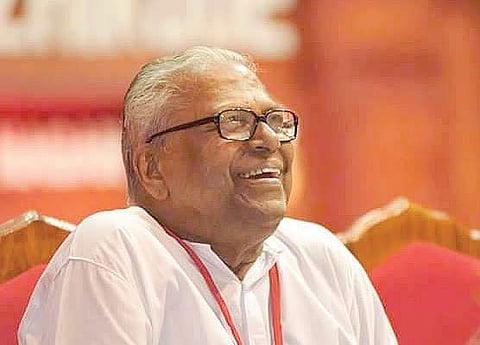

V S Achuthanandan represents the finest of the 1930s-40s generation of Alappuzha working-class leaders. All these daily wage workers with just primary education taught themselves in the trade union night schools and intensive political classes along with union organising activities, making them true organic intellectuals of the people. V S Achuthanandan was the tallest among them.
As with many other Alappuzha worker leaders, it was P Krishna Pillai who identified the organiser in young Achuthanandan and deputed him to Kuttanadu to organise the agricultural workers. Since then, the story of mobilisation of agricultural workers in Kerala has been intertwined with that of V S Achuthanandan. The struggle was not only for better wages but also against caste and for self-respect and dignity.
During the Punnapra-Vayalar armed uprising Achuthanandan was arrested and brutally tortured. He contributed to the resurrection of the movement and rose rapidly in the party leadership. He earned widespread admiration for winning maximum seats in the 1956 election to the legislative assembly from Alappuzha as its district secretary. It was for this reason that he was deputed to lead the election campaign for the prestigious by-election at Devikulam in 1958. Though no minister of EMS cabinet participated in the campaign, yet, CPI candidate Rosamma Punnoose had a resounding victory.
In the inner party struggle during the early 1960s he was with the left trend and was one of the 32 members who walked out of CPI National Council which sealed the split in the Communist Party. Since then, he has been one of the foremost leaders of CPI(M), being state secretary for 12 years and politburo member for 24 years. He was a member of the legislative assembly for 35 years. Whether in power or outside, he always identified himself with the struggles of the poor for land, wages and livelihood. He could communicate with them easily and that endeared him to the masses.
There were many occasions for me to closely interact and work with him. The first was during the People’s Plan Campaign, when after demise of EMS he became the Chairman of its High-Power Guidance Council. Every month we would undertake tours, visiting panchayats, reviewing the work and learning from practice.
The second occasion was when I worked as a member of his cabinet. The agitator Achuthanandan proved to be one of the most successful administrators also. For example, he had clear vision about the role Vizhinjam port could play in Kerala’s development and he tenaciously pursued the project against odds. The first disappointment was when Centre refused to give security clearance for the agency identified because of Chinese involvement. The second attempt after successful bidding was scuttled by forces behind the curtains. He wouldn’t give up. With the help of IFC an alternative landlord business model was developed. Then,the Union Environmental Ministry proved to be the spoilsport turning down twice the request for environmental study. Had Achuthanandan’s efforts fructified we would have had a functioning Vizhinjam port today.
The next occasion was my 2009 budget when I startled many by announcing an anti-recession package of Rs 5000 crore in the budget speech, after the plan and budget accounts were finalised. I found the chief minister receptive to my explanations of Keynesian tactics. This rather audacious action, which later was favourably commented on by RBI, could not have been carried out but for his support. His last contribution to the state was the Administrative Reforms Commission Report. During recent years he has been incapacitated by ill health. Yet he remains as popular as ever on his 100 birthday.